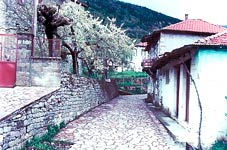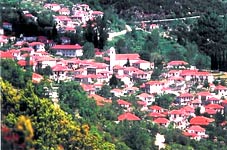 Platanos used to be the capital of the original rather small municipality of Proschios (with Klipaida and Pyllini) and then the capital Platanos municipality. Kato Platanos (former Vonorta) also belongs to this district. It is located on the eastern slopes of mount Alonaki (altitude 1418 meters) at an altitude of 860 meters.
Platanos used to be the capital of the original rather small municipality of Proschios (with Klipaida and Pyllini) and then the capital Platanos municipality. Kato Platanos (former Vonorta) also belongs to this district. It is located on the eastern slopes of mount Alonaki (altitude 1418 meters) at an altitude of 860 meters.
It is located within a beautiful forest with diverse flora (fir, cedar, cornel trees and others). It seems that before Platanos was built in its present location there were small settlements in the areas Bourlada, with the church of the Tehotokos (Paliokklisi) Pogoniska with the church Agia Paraskevi, Palialonia, Pognia, Aye Vlasis and Valsamos. There is also a scenario that in addition to these settlements there was a settlement in “Megali Vrysi” area which attracted the other settlements due to its healthy climate. It cannot be ruled out though that from Platanos settlement, which got its name from the plane tree of “Megali Vrysi”, the above small settlements were created for farmland purposes. Traces of ancient ruins have been found at Pougouiska, Pourlada Vonorta (St.Taxiarches), St. Athanasios (Milia), Fteri (St. George) and Megali Vrysi. Some of the findings have been timed at the post classical times by archaeologists.
Platanos has a long history; it was a prosperous and rich village. The number of stores that existed verifies this fact. Platanos is a traditional settlement.
 Stone houses are a majority and arouse great interest. Rontiraika (1847), the house of Margarits (1850), the house of Kolotourou (Koletta 1840) and the house of Aggelaki (1850) all with impressive rock reliefs are some of the oldest houses of Platanos. The St. Nikolas church stands out (1846) grandeur and domineering at the centre of the village. Its rythm is basillic with two beauteous and castellated steeples and a triconch arch on the altar, rare structural art. Impressive are the stone reliefs of the doorframes of the southern part of the church. Majestic is also the interior of the church with icons and heirlooms of great value.
Stone houses are a majority and arouse great interest. Rontiraika (1847), the house of Margarits (1850), the house of Kolotourou (Koletta 1840) and the house of Aggelaki (1850) all with impressive rock reliefs are some of the oldest houses of Platanos. The St. Nikolas church stands out (1846) grandeur and domineering at the centre of the village. Its rythm is basillic with two beauteous and castellated steeples and a triconch arch on the altar, rare structural art. Impressive are the stone reliefs of the doorframes of the southern part of the church. Majestic is also the interior of the church with icons and heirlooms of great value.
Noteworthy at the square of the village are two museums: a) National Resistance museum with photographic archives and a collection of related books and documents, b) the history – folklore museum with a significant collection of historic and folklore elements. As you walk through the cobblestone streets you may see other important buildings of the settlement like the school and the health centre, the rock faucets and the bust statues of Karaiskaki who had militarilize Platanos as well as eminent personalities of Platanos.
Megali Vrysi, a climb to the forest, a visit to the churches (Holy Archangels, St. George, St. Elias, St. Paraskevi) and to other picturesque spots of the village are some of the greater or smaller routes a visitor can take. South of Platanos is Kato Platanos (former Vonorta) settlement. It is a byzantine village and during that times (1454) it was a bit larger (population-wise) than Platanos.
SEE ALSO
